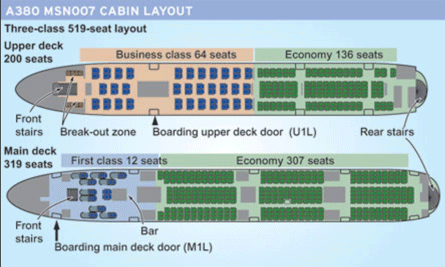Airbus's much-anticipated A380 media flight succeeded in demonstrating the aircraft's impressive airborne performance, although the relatively light passenger load means the on-board environment has yet to be experienced publicly under more testing conditions.
This tenth flight, on a blustery 7 February in Toulouse, was on board the 519-seat MSN007 (F-WWJB), which has so far clocked up just 31h. The aircraft was carrying 215 passengers, including 170 members of the press, and therefore operating with a fairly modest load factor of around 40%.
|
|---|
| Passengers boarded via two airbridges at Airbus's new delivery centre |
Boarding was through two airbridges at Airbus's new delivery centre at Toulouse Blagnac airport, at the upper-deck U1L door and main-deck M1L door, but a thorough security check at the airbridge entrance assisted with thinning the passenger flow.
There was no congestion at the upper-deck door, although at the foot of the forward inter-deck stairway natural interest in the cockpit was causing a slight bottleneck.
Among the more unusual aspects of the aircraft was the sense of disorientation created by its size and twin-deck design. There is little to distinguish either deck individually from that of a conventional twin-aisle aircraft, and similarly little to remind passengers that another deck even exists.
Flight AIB1007 lifted off at 13:18 from Blagnac's runway 32L, following a short ground run of about 20s, with a weight of 361t - well below the A380's maximum take-off weight of 560t. The 48t of fuel on board was sufficient for a flight duration of over 4h.
The scale of the double-decker was apparent as it climbed through the cloudy and unsettled sky, its ailerons successfully, if furiously, countering the instability.
Even from the rear upper deck cabin the take-off thrust from the Rolls-Royce Trent 900s was not overwhelming, and the upper deck provided a curious degree of isolation from other routine sounds such as undercarriage retraction.
The aircraft turned south towards the Pyrenees and climbed to 15,000ft (4,580m) to rendezvous with an Aerospatiale Corvette chase aircraft being used for air-to-air photography. Like other flights during the A380 test regime, AIB1007 was under the supervision of a separate air traffic control crew.
While on board MSN007, the members of the media had unrestricted access to the whole aircraft. The jet's rear spiral staircase, connecting the economy cabins, had a notice warning against more than 30 persons convening in the area, and using the staircase during turbulence.
Cabin service was undertaken by eight flight attendants from Lufthansa, three from Air France-KLM and another five from Airbus. On a regular flight the cabin staff would effectively act as two separate teams, one on each deck, with no inter-deck transfer. Each deck of MSN007 is fitted with two galleys but, owing to the nature of the flight, Airbus opted not to carry out a regular catering service, minimising obstruction to the aisles.
But chief purser and A380 cabin operation manager Anne Kerrien said: "In terms of the ergonomics and working conditions we have more space than on any other aircraft, and there's less noise - which means when we arrive after 15 flying hours we're not as tired."

The extra space was evident, particularly on the lower deck, and the aircraft - even with the bustle of camera crews - did not feel crowded. Forty-five minutes in, having climbed to 41,000ft, the A380 was cruising at Mach 0.85 heading north for Bordeaux and La Rochelle. We touched down at Toulouse, at a weight of 340t in a 20kt (37km/h) wind gusting to 30kt, at 15:19 - an uneventful 121min since departure.
Source: Flight International

















